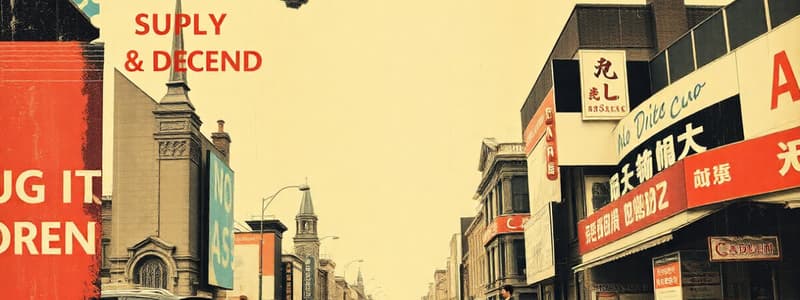Podcast
Questions and Answers
How do prices function within a market economy?
How do prices function within a market economy?
- They are determined by historical practices and customs.
- They remain static, providing stability and predictability for businesses.
- They act as signals, coordinating economic activity and guiding resource allocation. (correct)
- They are dictated by government regulations to ensure fair distribution.
What is the primary focus of monetary policy?
What is the primary focus of monetary policy?
- Regulating international trade agreements.
- Controlling the money supply and interest rates. (correct)
- Implementing government spending and taxation.
- Supporting specific industries to promote economic growth.
What does positive economics primarily deal with?
What does positive economics primarily deal with?
- Objective and testable statements about how the economy works. (correct)
- Ethical considerations in economic decision-making.
- Subjective statements on how the economy should operate.
- Value-based judgments on economic policy.
Which economic system relies on customs and historical practices to guide economic decisions?
Which economic system relies on customs and historical practices to guide economic decisions?
What is the key characteristic of a command economy?
What is the key characteristic of a command economy?
In economics, what does the term 'efficiency' refer to?
In economics, what does the term 'efficiency' refer to?
What is the primary focus of supply-side economics?
What is the primary focus of supply-side economics?
What is the significance of the Consumer Price Index (CPI)?
What is the significance of the Consumer Price Index (CPI)?
Which policy is most aligned with Keynesian economics during a recession?
Which policy is most aligned with Keynesian economics during a recession?
What is a key characteristic of behavioral economics?
What is a key characteristic of behavioral economics?
What is the fundamental concept of scarcity in economics?
What is the fundamental concept of scarcity in economics?
How does international trade impact domestic economies?
How does international trade impact domestic economies?
What is the unemployment rate an indicator of?
What is the unemployment rate an indicator of?
What is the main objective of economic development?
What is the main objective of economic development?
What is the definition of 'opportunity cost'?
What is the definition of 'opportunity cost'?
What is Gross Domestic Product (GDP)?
What is Gross Domestic Product (GDP)?
What is the primary goal of 'full employment'?
What is the primary goal of 'full employment'?
In the context of international economics, what does the 'balance of payments' refer to?
In the context of international economics, what does the 'balance of payments' refer to?
Which of the following is an example of 'physical capital'?
Which of the following is an example of 'physical capital'?
What does the concept of 'sustainability' emphasize in economics?
What does the concept of 'sustainability' emphasize in economics?
Flashcards
What is Economics?
What is Economics?
The social science studying resource allocation under scarcity.
Microeconomics
Microeconomics
Focuses on individual economic agents, like households and firms.
Macroeconomics
Macroeconomics
Studies the economy as a whole; GDP, inflation, and unemployment.
Scarcity
Scarcity
Signup and view all the flashcards
Opportunity Cost
Opportunity Cost
Signup and view all the flashcards
Efficiency
Efficiency
Signup and view all the flashcards
Market Economy
Market Economy
Signup and view all the flashcards
Command Economy
Command Economy
Signup and view all the flashcards
Mixed Economy
Mixed Economy
Signup and view all the flashcards
Gross Domestic Product (GDP)
Gross Domestic Product (GDP)
Signup and view all the flashcards
Inflation
Inflation
Signup and view all the flashcards
Unemployment rate
Unemployment rate
Signup and view all the flashcards
Interest rates
Interest rates
Signup and view all the flashcards
Fiscal policy
Fiscal policy
Signup and view all the flashcards
Monetary policy
Monetary policy
Signup and view all the flashcards
International trade
International trade
Signup and view all the flashcards
Foreign exchange rates
Foreign exchange rates
Signup and view all the flashcards
Equity
Equity
Signup and view all the flashcards
Sustainability
Sustainability
Signup and view all the flashcards
Economic Development
Economic Development
Signup and view all the flashcards
Study Notes
- Economics is a social science that studies how societies allocate scarce resources to satisfy unlimited wants and needs
- It examines the production, distribution, and consumption of goods and services
Microeconomics
- Microeconomics focuses on the behavior of individual economic agents, such as households, firms, and markets
- It analyzes how these agents make decisions in response to changes in prices, incentives, and resource allocation
- Key topics in microeconomics include supply and demand, market structures, consumer behavior, and production costs
- Supply and demand are fundamental concepts that determine the equilibrium price and quantity of goods and services in a market
- Market structures range from perfect competition to monopolies, each affecting market outcomes differently
- Consumer behavior explores how individuals make choices to maximize their satisfaction (utility) given their budget constraints
- Production costs analyze the expenses incurred by firms in producing goods and services
Macroeconomics
- Macroeconomics examines the behavior of the economy as a whole, focusing on aggregate variables such as GDP, inflation, and unemployment
- It seeks to understand the factors that determine economic growth, business cycles, and the overall level of economic activity
- Key topics in macroeconomics include fiscal policy, monetary policy, economic growth, and international trade
- Fiscal policy involves the use of government spending and taxation to influence the economy
- Monetary policy focuses on the actions of central banks to control the money supply and interest rates
- Economic growth studies the factors that contribute to the long-run expansion of an economy's productive capacity
- International trade analyzes the exchange of goods and services between countries and its impact on domestic economies
Key Economic Concepts
- Scarcity is the fundamental economic problem that resources are limited while wants and needs are unlimited
- Opportunity cost is the value of the next best alternative forgone when making a decision
- Efficiency refers to the optimal allocation of resources to maximize output and minimize waste
- Economic models are simplified representations of reality used to analyze and predict economic phenomena
- Positive economics deals with objective and testable statements about how the economy works
- Normative economics involves subjective and value-based statements about how the economy should be
Economic Systems
- Market economy is an economic system in which resources are allocated through the decentralized decisions of individual firms and households
- Prices act as signals to coordinate economic activity, guiding resource allocation and promoting efficiency
- Command economy is an economic system in which the government controls the allocation of resources and makes production decisions
- Mixed economy is a combination of market and command elements, with government intervention to correct market failures and promote social welfare
- Traditional economy relies on customs, traditions, and historical practices to guide economic decisions
Economic Indicators
- Gross Domestic Product (GDP) is the total value of goods and services produced within a country's borders in a specific period
- Inflation is the rate at which the general level of prices for goods and services is rising, and subsequently, purchasing power is falling
- Unemployment rate is the percentage of the labor force that is unemployed and actively seeking work
- Interest rates are the cost of borrowing money, expressed as a percentage of the principal amount
- Consumer Price Index (CPI) is a measure of the average change over time in the prices paid by urban consumers for a basket of consumer goods and services
- Exchange rates are the value of one currency in terms of another currency
Economic Theories
- Classical economics emphasizes the importance of free markets, limited government intervention, and the self-regulating nature of the economy
- Keynesian economics argues that government intervention is necessary to stabilize the economy and mitigate the effects of recessions
- Monetarism focuses on the role of money supply in influencing economic activity and advocates for stable monetary policy
- Supply-side economics emphasizes the importance of tax cuts and deregulation to stimulate economic growth
- Behavioral economics incorporates psychological insights into economic models to better understand decision-making
Economic Goals
- Economic growth is an increase in the production of goods and services over time, leading to higher living standards
- Full employment is a situation in which the economy is operating at its potential output level, with minimal unemployment
- Price stability is maintaining a low and stable rate of inflation to preserve the purchasing power of money
- Equity is the fair distribution of resources and opportunities among members of society
- Efficiency is the optimal allocation of resources to maximize output and minimize waste
- Sustainability is meeting the needs of the present without compromising the ability of future generations to meet their own needs
Economic Challenges
- Inequality is the unequal distribution of income and wealth among individuals or groups in society
- Poverty is a state of deprivation in which individuals lack the basic necessities of life, such as food, shelter, and clothing
- Unemployment is the state of being jobless and actively seeking work, causing financial hardship and social distress
- Inflation is the sustained increase in the general price level, reducing purchasing power and eroding savings
- Economic instability is the volatility of economic activity, characterized by booms and busts, leading to uncertainty and hardship
- Environmental degradation is the deterioration of the environment due to pollution, resource depletion, and climate change
Economic Policy
- Fiscal policy involves the use of government spending and taxation to influence the economy
- Monetary policy focuses on the actions of central banks to control the money supply and interest rates
- Regulatory policy involves the use of government regulations to influence economic behavior and promote social welfare
- Trade policy involves the use of tariffs, quotas, and other measures to regulate international trade
- Industrial policy involves government support for specific industries to promote economic growth and competitiveness
- Development policy involves strategies to promote economic development in developing countries, such as foreign aid, trade liberalization, and investment promotion
International Economics
- International trade is the exchange of goods and services between countries
- Foreign exchange rates are the value of one currency in terms of another currency
- Balance of payments is a record of all economic transactions between a country and the rest of the world
- Globalization is the increasing integration of economies, cultures, and societies through cross-border flows of goods, services, capital, and information
- International organizations are institutions that facilitate international cooperation and promote economic development, such as the World Trade Organization (WTO), the International Monetary Fund (IMF), and the World Bank
Economic Development
- Economic development is the process of improving the economic well-being and quality of life of a country's population
- Human capital is the knowledge, skills, and abilities of individuals that contribute to economic productivity
- Physical capital is the infrastructure, equipment, and machinery used in the production of goods and services
- Technology is the application of scientific knowledge to solve practical problems and improve productivity
- Institutions are the rules, laws, and norms that govern economic activity and promote economic development
- Sustainable development is development that meets the needs of the present without compromising the ability of future generations to meet their own needs
Studying That Suits You
Use AI to generate personalized quizzes and flashcards to suit your learning preferences.




